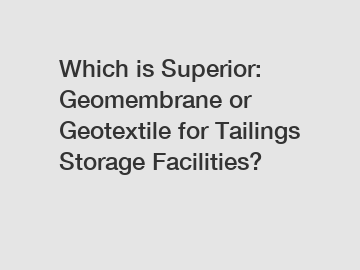Which is Superior: Geomembrane or Geotextile for Tailings Storage Facilities?
Which is Superior: Geomembrane or Geotextile for Tailings Storage Facilities?
Tailings storage facilities (TSFs) play a crucial role in the mining industry as they are responsible for containing and managing the waste materials produced during the extraction and processing of minerals. One of the key decisions that operators must make when constructing a TSF is choosing the most suitable lining system to ensure proper containment and avoid environmental risks. This article will compare two commonly used materials for lining TSFs – geomembranes and geotextiles – and discuss their respective advantages and disadvantages.
Geomembrane: The Ultimate Barrier.

Geomembranes are synthetic materials typically made of high-density polyethylene (HDPE) or low-density polyethylene (LDPE). They are specifically engineered to function as an impermeable barrier, preventing the seepage of liquids and the release of contaminants into the surrounding environment. In TSFs, geomembranes are typically installed as the primary lining system.
Advantages of Geomembranes:
1. Excellent chemical resistance: Geomembranes are highly resistant to the chemical compounds found in tailings, ensuring long-term stability and preventing the migration of harmful substances.
2. Impermeability: The main advantage of geomembranes is their ability to provide an impermeable barrier, minimizing the risk of leakage and groundwater contamination.
3. Easy installation: Geomembranes can be delivered to the site pre-fabricated in large panels, significantly reducing installation time and cost.
Disadvantages of Geomembranes:
1. Puncture susceptibility: Geomembranes can be prone to punctures during installation or due to sharp objects present in the tailings. However, these risks can be mitigated through proper construction techniques and the use of protective measures such as geotextile underlays.
2. Limited flexibility: Geomembranes are not as flexible as geotextiles, making them more susceptible to stress and strain caused by settlement, slope deformations, and seismic activities. Special attention must be given to design and construction to accommodate such factors.
Geotextile: Reinforcing and Filtration.
Geotextiles, on the other hand, are permeable materials consisting of synthetic fibers or natural materials like jute or coconut fibers. They are commonly used in conjunction with geomembranes as secondary or composite liners in TSFs to provide additional reinforcement and filtration functions.
Advantages of Geotextiles:
1. Filtration: Geotextiles allow for the controlled passage of liquids while retaining soil particles. This function is vital in tailings management to prevent clogging and maintain the integrity of the system.
2. Flexibility: Geotextiles have high tensile strength and flexibility, which enables them to accommodate settlement and differential movements within the TSF and provide additional structural support.
3. Cost-effective: Geotextiles are generally less expensive than geomembranes, making them an attractive option for secondary lining systems in cases where the risk of seepage is lower.
Disadvantages of Geotextiles:
1. Limited containment properties: Geotextiles alone cannot completely contain tailings material and prevent seepage. As a result, their use as the primary lining system in TSFs is not recommended.
2. Vulnerability to UV rays: Geotextiles can be degraded by prolonged exposure to ultraviolet (UV) rays. To protect them, geomembranes or other UV-resistant materials should be used in conjunction with geotextiles.
Conclusion:
In the debate over which material is superior for lining TSFs, both geomembranes and geotextiles have their pros and cons. While geomembranes are excellent at providing a robust and impermeable barrier, geotextiles offer additional benefits in terms of reinforcement and filtration. The choice between the two will depend on site-specific conditions, the level of seepage risk, and budget considerations.
To learn more about which lining system would be most suitable for your tailings storage facility, contact us today.
Keywords: contact us.
Want more information on features and applications of geogrid for sale, trp geomembranes custom, eva smooth geomembrane manufacturer? Feel free to contact us.
171
0
0


Comments
All Comments (0)